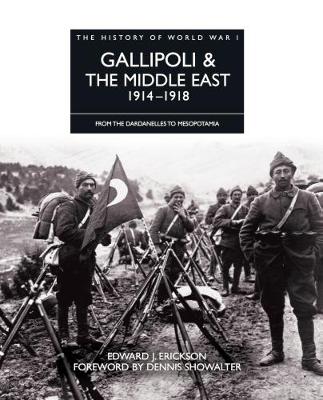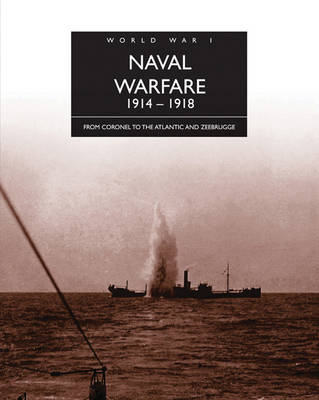The History of World War I
2 total works
The war in the Middle East was a struggle between the Ottoman Turks, British, French and Russians for control of the lands and peoples held by the Ottoman Empire since the 1400s. Although known as the 'Sick Man of Europe', the empire still controlled significant parts of the Middle East. Intense diplomatic pressure from Germany culminated in a decision to join the Central Powers in October 1914. Russia had long coveted Ottoman territory, and the two empires clashed in the Caucasus. The Turks suffered a major defeat at Sarakamis, and their lack of success continued into 1916. However the Russian revolutions of 1917 led to the Russian forces in the area dissipating, and the following year the new Muslim-only 'Army of Islam' was sent to claim oil-rich Baku for the Turks, ousting the British-led defenders. In Mesopotamia (modern Iraq) the Ottoman defenders were at first defeated by the British, but General Townshend's decision to stay in Kut-al-Amara resulted in his eventual surrender in April 1916, a huge blow to Allied morale. The loss prompted the despatch of a much larger British force, and the subsequent capture of Baghdad and Mosul by the war's end. The persistent Ottoman threat to the Suez Canal led to the British offensive in Palestine. The capture of Jerusalem by General Allenby in 1917 was a welcome Christmas present for the Allies, while his subsequent victory at Megiddo, combined with the Arab Revolt inspired by Lawrence of Arabia, resulted in the capture of Damascus. However the defining struggle in this theatre was Gallipoli, the first time in over 200 years that Ottoman forces stood toe-to-toe with European troops and prevailed. The Gallipoli campaign had a profound effect not only on the Turks, but on the British, Australian and New Zealand troops who fought there, and marked the beginning of the end of European military supremacy in the region. With the aid of over 300 photographs, complemented by full-colour maps, Gallipoli and the Middle East provides a detailed guide to the background and conduct of World War I in all the theatres in which Ottoman forces were engaged.
At the start of the war, the German Empire had cruisers scattered across the globe, some of which were subsequently used to attack Allied merchant shipping. The British Royal Navy systematically hunted them down, though not without some embarrassment from its inability to protect Allied shipping. However, the bulk of the German East-Asia squadron did not have orders to raid shipping and was instead underway to Germany when it encountered elements of the British fleet. Soon after the outbreak of hostilities, Britain initiated a naval blockade of Germany. The strategy proved effective, cutting off vital military and civilian supplies.
The 1916 Battle of Jutland developed into the largest naval battle of the war, the only full-scale clash of battleships during the war. The Kaiserliche Marine's High Seas Fleet, commanded by Vice Admiral Reinhard Scheer, squared off against the Royal Navy's Grand Fleet, led by Admiral Sir John Jellicoe. The engagement was a standoff, as the Germans, outmaneuvered by the larger British fleet, managed to escape and inflicted more damage to the British fleet than they received. Strategically, however, the British asserted their control of the sea, and the bulk of the German surface fleet remained confined to port for the duration of the war.
German U-boats attempted to cut the supply lines between North America and Britain. The nature of submarine warfare meant that attacks often came without warning, giving the crews of the merchant ships little hope of survival. The U-boat threat lessened in 1917, when merchant ships entered convoys escorted by destroyers.
With the last few men who served in World War I now dying out, and the 90th anniversary of the Armistice coming in November 2008, there is no better time to revaluate this controversial war and shed fresh light on the conflict.
With the aid of numerous black and white and colour photographs, many previously unpublished, the World War I series recreates the battles and campaigns that raged across the surface of the globe, on land, at sea and in the air. The text is complemented by full-colour maps that guide the reader through specific actions and campaigns.
The 1916 Battle of Jutland developed into the largest naval battle of the war, the only full-scale clash of battleships during the war. The Kaiserliche Marine's High Seas Fleet, commanded by Vice Admiral Reinhard Scheer, squared off against the Royal Navy's Grand Fleet, led by Admiral Sir John Jellicoe. The engagement was a standoff, as the Germans, outmaneuvered by the larger British fleet, managed to escape and inflicted more damage to the British fleet than they received. Strategically, however, the British asserted their control of the sea, and the bulk of the German surface fleet remained confined to port for the duration of the war.
German U-boats attempted to cut the supply lines between North America and Britain. The nature of submarine warfare meant that attacks often came without warning, giving the crews of the merchant ships little hope of survival. The U-boat threat lessened in 1917, when merchant ships entered convoys escorted by destroyers.
With the last few men who served in World War I now dying out, and the 90th anniversary of the Armistice coming in November 2008, there is no better time to revaluate this controversial war and shed fresh light on the conflict.
With the aid of numerous black and white and colour photographs, many previously unpublished, the World War I series recreates the battles and campaigns that raged across the surface of the globe, on land, at sea and in the air. The text is complemented by full-colour maps that guide the reader through specific actions and campaigns.

